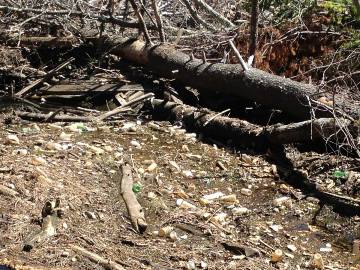|
Blackstone River Watershed Association
|
|
|
BRWA NEWS
|
Countdown to Clean Up
April showers bring May flowers. They also wash litter and other
contaminants into our wetlands, streams, ponds, and rivers. That's why we
need YOU to pitch in for the BRWA's annual Earthday Cleanup
on Sunday April 17th.
Spring litter near Plummers Landing.

|
Whether you've helped out for years with us or this is your first time, we
welcome you! After the cleanup, stick around for our Clean & Green Fair,
co-sponsored by Alternative Unlimited, Inc. for fun activities and
information about water protection. To sign up or to receive more
information, contact us at
events@thebrwa.org.
top
|
3...2....1....Cast!
The BRWA is excited to hold our second annual Family Fun Fishing Day on
May 21 (rain date May 22). Last year's event was a tremendous success
with over 100 people participating and we're looking forward to sharing
the fun of fishing with even more folks this year.
Both experienced and novice anglers are welcome! We'll offer casting
demonstrations and provide equipment. There will also be educational
games, refreshments, and raffles to add even more fun to the
family-friendly event. Watch our website for more details.
top
|
Come In, the Water's Fine!
Join us June 11th for our second annual Day on the Blackstone.
Last year, dozens of canoers and kayakers journeyed downstream from Uxbridge
to Blackstone during an exciting day of paddling, nature observations,
and history lessons. This is a unique opportunity to discover the
Blackstone up close and personal! Watch for more information as we get
closer to the date.
top
|
|
CALENDAR OF EVENTS
|
March 16 is National Freedom of Information Day. It commemorates
James Madison who crafted our Constitution and promoted
"openess in government". Today, environmental advocates continue to push
local, state, and federal offices to provide access to the information we
need to help protect our waterways and other natural resources. Let your voice be heard!
|
| 3/5 |
Blackstone River Coalition’s Annual Water Quality Monitoring Summit.
9:15 a.m. -12:00 p.m. Hopedale Community House, 43 Hope St, Hopedale, MA.
Info: Susan Thomas, acadia94@verizon.net
or 508-839-9488.
|
| 3/7 |
Trout Unlimited Central Mass Chapter Monthly Meeting.
6:00 -9:00 p.m. Auburn Sportsman's Club. 50 Elm Street, Auburn, MA.
info
|
| 3/16 |
Blackstone River Watershed Council Monthly Meeting.
6:30pm - 8:30pm. Lincoln RI.
info
|
| 3/19, 3/20 |
Experience Maple Sugaring, How sweet it is!Blackstone River and Canal State
Heritage Park. 11:00 a.m. - 3:00 p.m. River Bend Farm Visitor Center. 287 Oak Street, Uxbridge.
The Department of Conservation & Recreation, in partnership with
Blackstone Heritage Corridor, Inc. will partner once again continue the
tradition of Maple Sugaring at River Bend Farm.
info
|
| 3/19 |
2016 RI Land and Water Conservation Summit.
7:45 a.m. - 4:00 p.m. URI, Kingson RI.
info
|
| 3/22 |
World Water Day.
info
|
| 3/24 |
BRWA Board Meeting. 6:45 p.m. to 8:00 p.m. 287 Oak St., Uxbridge.
info
|
| 4/14 |
Linking Landscapes for Massachusetts Wildlife: Citizen Science and Road
Ecology can Benefit Wildlife and Motorists. Mass Wildlife Speaker Series.
7 p.m. 1 Rabbit Hill Rd, Westboro. Info: 508-389-6300 or
Mass.com/MassWildlife150.
|
| 4/17 |
BRWA's Annual EarthDay Cleanup. 1:00 - 3:00 p.m. River Bend Farm Visitor Center,
Uxbridge and sites throughout the watershed. See above for details.
|
top
|
THINK GLOBAL, ACT LOCAL
|
Water Quantity Draws Attention
We have all been hearing about the problems being experienced in Flint,
Michigan concerning water quality. Municipalities also face problems with
maintaining water quantity. Shrewsbury is the latest municipality
within the Blackstone River watershed to start addressing the quantity of
its public water supply. Town officers are considering how to respond to a
projected shortfall brought about by proposed business development along major
travel routes in town.
As of last year, Shrewsbury withdrawals 3.6 million gallons/day from the
Blackstone River watershed primarily via the Homes Farm wells within the Poor
Farm subwatershed. Additional water is drawn from a well in the Sewell Brook
sub watershed. Current state permits allow for an additional
0.75 million gallons/day pumping, but not beyond that amount and not from
additional local aquifers. The town's projected need is for
6 million gallons/day to support expanded economic development.
So, how should towns like Shrewsbury deal with such shortfalls? One approach
is to increase water rates as an incentive to reduce usage.
User rates for Shrewsbury residents and businesses were increased as of
January 1, 2016. Whether this increase is sufficient to bring about a
meaningful level of conservation needs to be monitored.
A second approach is education and outreach. Shrewsbury put
its "Water Conservation Project" in place ten years ago in response to MA DEP
regulations. The education component includes volunteer conservation tips.
However, a decade of this approach has not been effective enough to avoid the
current deficit dilemma. Additional mandatory restrictions on summer usage
have been placed through the town's general by-laws.
A third approach is for towns to seek alternative water
sources. Shrewsbury may choose to connect to Worcester's system or
it could join the MA Water Resource Authority, which was established in 1985
to provide water and sewer resources to Boston along with other eastern and
central municipalities.
It is critical that environmental advocates have a say in municipal plans for
water withdrawals because of potential adverse impacts to wetland and stream
function and to aquatic habitat. Of course, places like California have been
battling water shortages for a while now. Residents and officials are facing
tough choices that those of us in New England have not had to face to that
degree...yet.
top
|
More on MS4
We continue, in this issue, to provide background information on the
forthcoming stormwater permit for Massachusetts.
- Timing: Expected to be issued in March and take
effect later this year.
- Oversight: Under 2003 Permit, EPA and Mass DEP
informally divided responsibilities; DEP handled outreach/technical
assistance, and EPA assumed compliance/enforcement.
- Delegation: MA and N.H. are not currently delegated
states; CT, VT, and RI are.
- Standards: Nutrients - primarily phosphorus, and
bacteria are top contaminants addressed in draft permit.
- Redevelopment: EPA proposes similar standards for
new development and redevelopment projects; Mass DEP believes they should
be treated differently.
- Recharge: Mass DEP opposes EPA's proposed
one-size-fits-all 1" groundwater recharge rate that doesn't take into
account the different permeability of sandy and clayey soils.
- Reporting: MA DEP objects to the increase of
reporting requirements from ~ 30 to over 250 and its associated costs; EPA
projects only minimal costs for the increased reporting.
- Enforcement: Mass DEP favors a programmatic rather
than enforcement approach in which a 5-year permitting cycle is utilized.
Towns not meeting water quality standards at cycle end would be subject to
increased requirements but not necessarily penalties.
top
|
|
BE GREEN
|
Toss the Teflon
 Polytetrafluoroethylene (PTFE), also known as Teflon, is a chemical
discovered by DuPont in 1938; perfluorooctanoic acid (PFOA) is used in its
manufacture. Because of its chemical properties, Teflon was developed as a
coating for non-stick cookware, and it has been used for this purpose for generations.
Polytetrafluoroethylene (PTFE), also known as Teflon, is a chemical
discovered by DuPont in 1938; perfluorooctanoic acid (PFOA) is used in its
manufacture. Because of its chemical properties, Teflon was developed as a
coating for non-stick cookware, and it has been used for this purpose for generations.
The chemicals in PTFE-based non-stick cookware can be released at temperatures
above 500 degrees F—for example, when a pan is left on a stovetop to warm up.
They can also enter food when fragments of the coating itself are scraped off.
PFOAs can also enter the environment from industrial sites.
Concerns have been raised about the potential health effects of PFOA. The EPA
characterizes PFOA as an "emerging contaminant" that needs additional
research to establish a full understanding of its impacts on human health.
Meanwhile, the village of Hoosic Falls, NY is undergoing intense scientific
monitoring and health advisories due to contamination of its public drinking
water with PFOA from a nearby Saint-Gobain manufacturing plant.
These health considerations have prompted many to consider Teflon-free
cookware. Here are some options, including some that provide non-stick surfaces:
- Stainless Steel: stainless steel is strong, long
lasting, non-toxic, and excellent for cooking.
- Cast Iron: like stainless steel, cast iron is strong,
long lasting, non-toxic, and excellent for cooking. It does require more
care than stainless steel to prevent rust.
- Ceramic: There is a range of ceramic cookware
products, including some that provide non-stick surfaces (see below).
Ceramic cookware can be long lasting and can offer excellent cooking
properties. Some ceramics, however, can contain toxic materials.
- Anodized Aluminum: There have been concerns about
the possible health effects of aluminum cookware for decades, because
aluminum is highly reactive and can enter food in the cooking process.
However, when aluminum cookware undergoes a process called anodization, a
hard, non-reactive coating is added to the cookware, making the surface
non-stick and preventing aluminum from entering food.
- Non-Stick “Green” Cookware: Cookware that does not
stick to food has a tremendous appeal: food does not get burned on the
pan, and non-stick cookware is very easy to clean. There are a variety of
green non-stick cookware options, including GreenPan’s “Thermolon” cookware
that advertises that it can be heated to 850 degrees F with no release of
toxic fumes, and Scanpan cookware that features a “Green Tek” coating.
 To read more about green cookware options, visit the following sites. Bon appetite!
To read more about green cookware options, visit the following sites. Bon appetite!
“Green Pans: The Pros and the Cons,” on Best Cookware Finds
“Top Picks for Eco-Friendly Non-Stick Cookware,“ on Green Family
“4 Types of Nontoxic, Eco-Friendly Cookware That’s Safe for You and Your Family,“ on Ecowatch
top
|
|
REFLECTIONS
|
“It is not half so important to know as to feel.” Rachel Carson
The Water Nymphs by Ellis Parker Butler (1869 - 1937)
They hide in the brook when I seek to draw nearer,
Laughing amain when I feign to depart;
Often I hear them, now faint and now clearer—
Innocent bold or so sweetly discreet.
Are they Nymphs of the Stream at their playing
Or but the brook I mistook for a voice?
Little care I; for, despite harsh Time’s flaying,
Brook voice or Nymph voice still makes me rejoice.
top
|
Views & opinions expressed in linked websites do not necessarily
state or reflect those of the BRWA.
|
|
Your input is crucial to this eNewsletter. If you have a local
watershed-related story, information of interest to our subscribers, or
comments about this publication, drop an email to the editor.
The Blackstone River Watershed Association (BRWA) has a mission to
engage, educate, and advocate for improved water quality in the Blackstone
River Watershed; its objectives are to:
- Engage the public in watershed stewardship activities,
- Educate members, supporters, and residents on watershed protection strategies, and
- Advocate to local residents, community leaders, non-profit partners, and
state regulators to take actions that will help to ensure our waterways continue
to provide healthy habitat and enjoyable recreational opportunities.
The BRWA eNewsletter is published monthly by the Blackstone River Watershed
Association. BRWA is a 501(c)(3) non-profit organization.
Editor: Susan Thomas susan.thomas@thebrwa.org
Mailing address: BRWA, 271 Oak Street Uxbridge, MA 01569
Phone: 508-278-5200 Web: www.thebrwa.org
Click here for back issues.
|
|




 To read more about green cookware options, visit the following sites. Bon appetite!
To read more about green cookware options, visit the following sites. Bon appetite!
